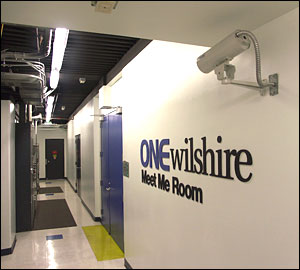Place for non-place
Post do NPR mostra como hotéis para servidores (“carrier hotel”) e grandes empresas de technologia criam um lugar para as tecnologias do “não-lugar”. Esses hotéis agregam infraestrutura de rede e várias impresas que podem criar conexões físicas facilmente entre elas. Um novo lugar surge e, como um hotel, cria ao mesmo tempo lugar de mobilidade e repouso…Trechos:

“(…) But the Internet is also a physical thing: a global network of cables, switches and hulky equipment. And all of that converges in places such as One Wilshire, a high-rise building in downtown Los Angeles.
If the Internet is a superhighway, One Wilshire is a really popular roadside hotel. It’s a 30-story building, and once exclusively housed law offices. CRG West, a Carlyle Group company, manages the property.
David Dunn of CRG West says 23 of the building’s floors are now designed to house not people, but some of the most important communications infrastructure in the country.

In the tech industry, this site is what’s known as a ‘carrier hotel.’ The occupants: connection hardware from nearly 300 Internet and telecommunications giants from around the world. Familiar U.S. companies such as AT&T and Google are here, but so are carriers from Europe, India and Asia.
And like the guests in a regular hotel, these networks can get to know each other. So if one telecom company needed to link up with another, it’s much easier when they’re under the same roof.
That can be particularly helpful in the event of a disaster like the December 2006 earthquake that struck Taiwan, severing critical undersea fiber optic cables. Most voice and data traffic into and out of Taiwan was slowed or halted, and connectivity to and from other Asian countries was drastically reduced.
Getting to the bottom of the ocean and repairing the cables has taken months. But places such as One Wilshire were able to re-route some of that Internet and voice traffic through their facility within days.
Some observers says the role carrier hotels play in the Internet’s ability to cope with disasters, could make them an attractive target for terrorists. Could ‘carrier hotels’ like One Wilshire be targeted because of their importance in global communications? And what if an earthquake or other natural disaster hit Los Angeles, disabling this critical site?
(…) ‘The thing we learned from the Taiwanese earthquake is that the Internet actually works,” says Schneier. “With all of the security problems we have, the one thing the Internet was designed to survive was physical failure of nodes. The loss of nodes was supposed to not affect the Net, or at least affect it in a graceful way. And that’s exactly what happened.'(…)
